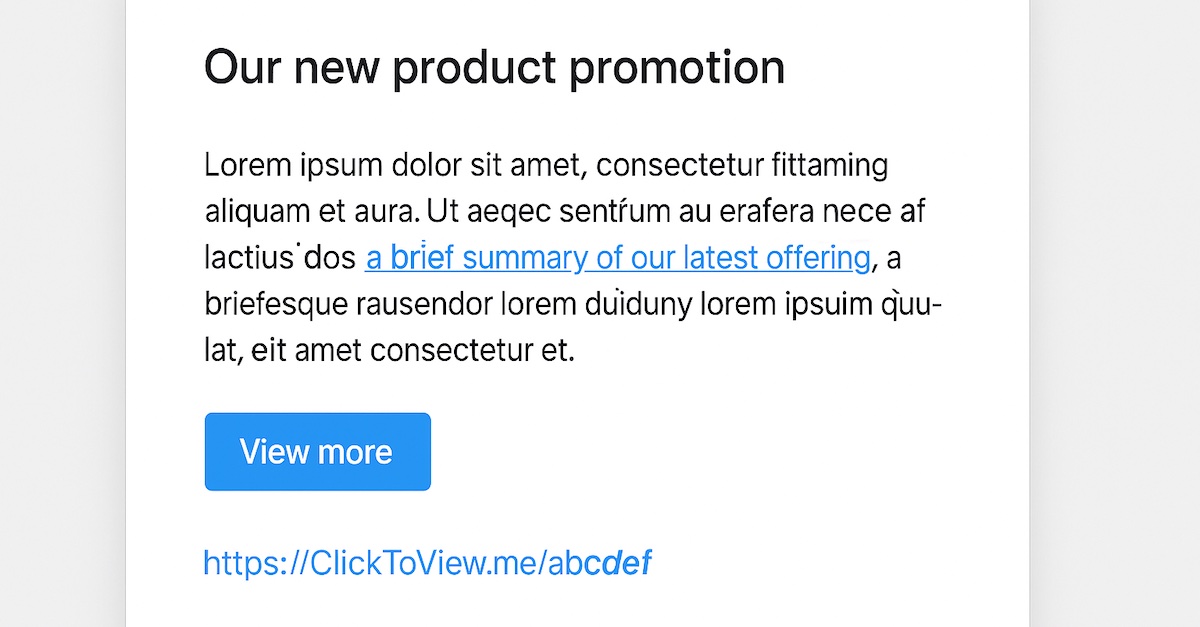Which Link in an Email Do People Click on the Most?

Marketers have been sending emails with hyperlinks for decades. We tend to assume that the big call-to-action (CTA) button is the star of the show — the visual anchor that carries most of the clicks. Or perhaps it’s the contextual link inside a paragraph, smoothly integrated into the flow of text. But when you actually look at the numbers, the winner is often neither.
In a recent test with a fictitious but realistic campaign, we found that the humble HTTPS shortlink outperformed both the button and the text link. That’s right: the simple link, visible in its raw form, captured the majority of clicks. Let’s explore why.
The test: three links, one email
Imagine a promotional email designed to drive readers to a landing page. The copy introduces the product, highlights the offer, and provides multiple opportunities to click through. Specifically, the email contains three distinct links:
- Inline Text Link – A short sentence in a paragraph contains a highlighted anchor link: “… learn more about our latest features here.”
- CTA Button (Image Link) – A large, centered button graphic that reads: View More →
- HTTPS Shortlink – A plain text link placed near the bottom: https://ClickToView.me/abcdef
All three links point to the same landing page. The only difference is their presentation.
The result: the HTTPS link wins
In our test, more than 60% of all clicks came from the visible HTTPS shortlink. The button and the inline text link split the remainder, with the button generally doing better than the anchor, but still not taking the lead.
At first glance, this seems surprising. After all, marketers have been trained to design buttons as the main conversion driver. Buttons are bigger, more colorful, and often placed “above the fold.” They should win, right? But human behavior tells a different story.
Why people click on visible HTTPS links
There are several reasons why readers prefer a plain HTTPS link over more traditional embedded links:
- Perceived Trust – A visible HTTPS link looks real. Hidden links behind text or buttons can feel opaque.
- Transparency vs. Obscurity – On mobile especially, you can’t hover to preview a hidden link. A plain URL removes that uncertainty.
- Simplicity and Habit – People have been trained for decades to recognise and trust visible URLs.
- Consistency Across Devices – Buttons and styled anchors render differently across email clients. A visible HTTPS link works everywhere.
But don’t they know it’s a redirect?
One counter-argument is that a shortlink doesn’t tell the full story either. After all, a URL like https://ClickToView.me/abcdef will redirect to another destination. So why should people prefer it?
The answer lies in relative trust. Even though the redirect is hidden, users still see a “real” URL in front of them — one that begins with HTTPS, with a readable domain name. That feels safer than clicking a button image or an underlined word that conceals the link entirely.
What this means for marketers
The lesson here is not to abandon buttons or anchor text links. Instead, the insight is that including a visible HTTPS link in your emails may significantly increase total click-through rates.
Together, buttons, anchors, and visible links cover different user preferences. But if you want to maximise clicks, the visible shortlink is the unsung hero.
Practical tips
- Always include a visible link – Many readers scroll down looking for it.
- Use branded or CTA shortlinks – e.g. ClickToView.me, which both builds trust and primes behavior.
- Place it strategically – Add the shortlink after your main CTA copy, where it feels natural.
- Test across campaigns – You may find the shortlink consistently wins with different audiences.
Conclusion
In marketing, intuition often says one thing, but data reveals another. While flashy buttons and elegant anchors are valuable, the plain HTTPS shortlink may be the true workhorse of email engagement.
Our research shows it can drive more than 60% of clicks, likely because it satisfies the modern reader’s need for trust, transparency, and simplicity. Far from being old-fashioned, the visible link is alive and well — and perhaps the most important link in your email.